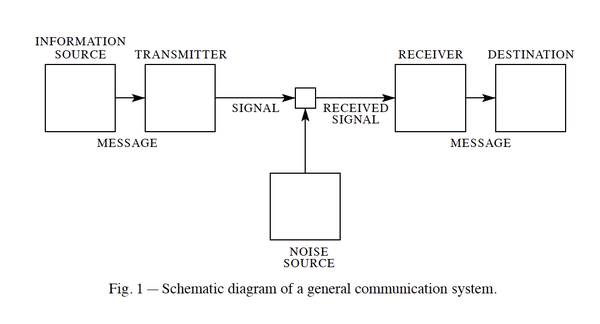User:Manetta/threeobjects: Difference between revisions
(Created page with "==text : a Mathematical Theory of Communication, by Claude Shannon== ('''what''') This [http://cm.bell-labs.com/cm/ms/what/shannonday/shannon1948.pdf article] written by Claud...") |
|||
| Line 20: | Line 20: | ||
==media object : XML file== | ==media object : XML file== | ||
('''what''') | |||
XML stands for 'Extensible Markup Language', a programming markup language developed in 1996, that is both human-readible as machine-readible. The design goals of XML emphasize simplicity, generality, and usability over the Internet.<ref name="wiki">[http://www.w3.org/TR/REC-xml/#sec-origin-goals XML design goals], via [http://en.wikipedia.org/wiki/XML#cite_note-XML_Goals-5 Wikipedia's page on XML]]</ref> In XML it is possible to define the type of content that is displayed, which is different in for example HTML. HTML does name the type of content as well, but on a higher level of abstraction. For example: a piece of text could be placed into a '<p>' tag, which tells any reciever that this text is a paragraph. In XML it is possible to use tags as <title>, <author>, <year>, <price>. | |||
('''how''') | |||
('''why''') | |||
This more specific way of wrapping the content creates more possibilities to give different commands to different types of content. I can imagine that this could lead to interesting results in a typographic translation of a XML written text (for example). | |||
<references /> | |||
Revision as of 12:38, 8 October 2014
text : a Mathematical Theory of Communication, by Claude Shannon
(what) This article written by Claude Shannon in 1948[1], is known as the foundation of the information theory. It is the official mathematical paper written for an academic audience, which makes it quite hard for a non-academic reader to understand the author's ideas in detail. Shannon speaks about the influence that a transmission has on a message, at the moment that it is being transmitted from the source to its destination. This idea is structured through terms as 'information source', 'transmitter', 'channel', 'reciever' and 'destination'. Another interesting part of the text is the paragraph that speaks about the connection between a symbol and its frequency of appearence in the Englisch language. In the accompaning examples, Shannon presents the reader how a string of symbols is ordered, untill they appear in the correct order and present legible words.
(how) I got to know about this article through another article written by Angie Keefer, called Octopus in Plan View[2]. The different sources in the text present a broad range of differnt perspectives towards naming, describing and the influence that has on the content that is perceived.
(why) The way that technology and also language influences our perception, is a field that interests me. The very clear structure in Shannon's ideas are attractive, and fit the content that the text is speaking about very well. He divides his ideas up like it are mathematical formulas. The ideas that he discusses in this text are dated from 1948, but still relevent today.
Though I'm looking forward to read the more approachable version of this text Recent Contributions to The Mathematical Theory of Communication, written by Warren Weaver in 1949.
- ↑ The text was published in 1949 in a book called 'THE mathematical theory of communication'. This shift from 'a theory' to 'the theory' is a small but significant element, which shows the importance of the text in that time.
- ↑ This text is published by the Serving Library, a NY based group of graphic designers/writers, working from the idea of a traveling library, producing its content on its way through collaborations and exhibitions.
art piece : Posterwall, by Lust / jcj vanderheyden
media object : XML file
(what)
XML stands for 'Extensible Markup Language', a programming markup language developed in 1996, that is both human-readible as machine-readible. The design goals of XML emphasize simplicity, generality, and usability over the Internet.[1] In XML it is possible to define the type of content that is displayed, which is different in for example HTML. HTML does name the type of content as well, but on a higher level of abstraction. For example: a piece of text could be placed into a '
' tag, which tells any reciever that this text is a paragraph. In XML it is possible to use tags as <title>, <author>, <year>, <price>. (how) (why) This more specific way of wrapping the content creates more possibilities to give different commands to different types of content. I can imagine that this could lead to interesting results in a typographic translation of a XML written text (for example).

